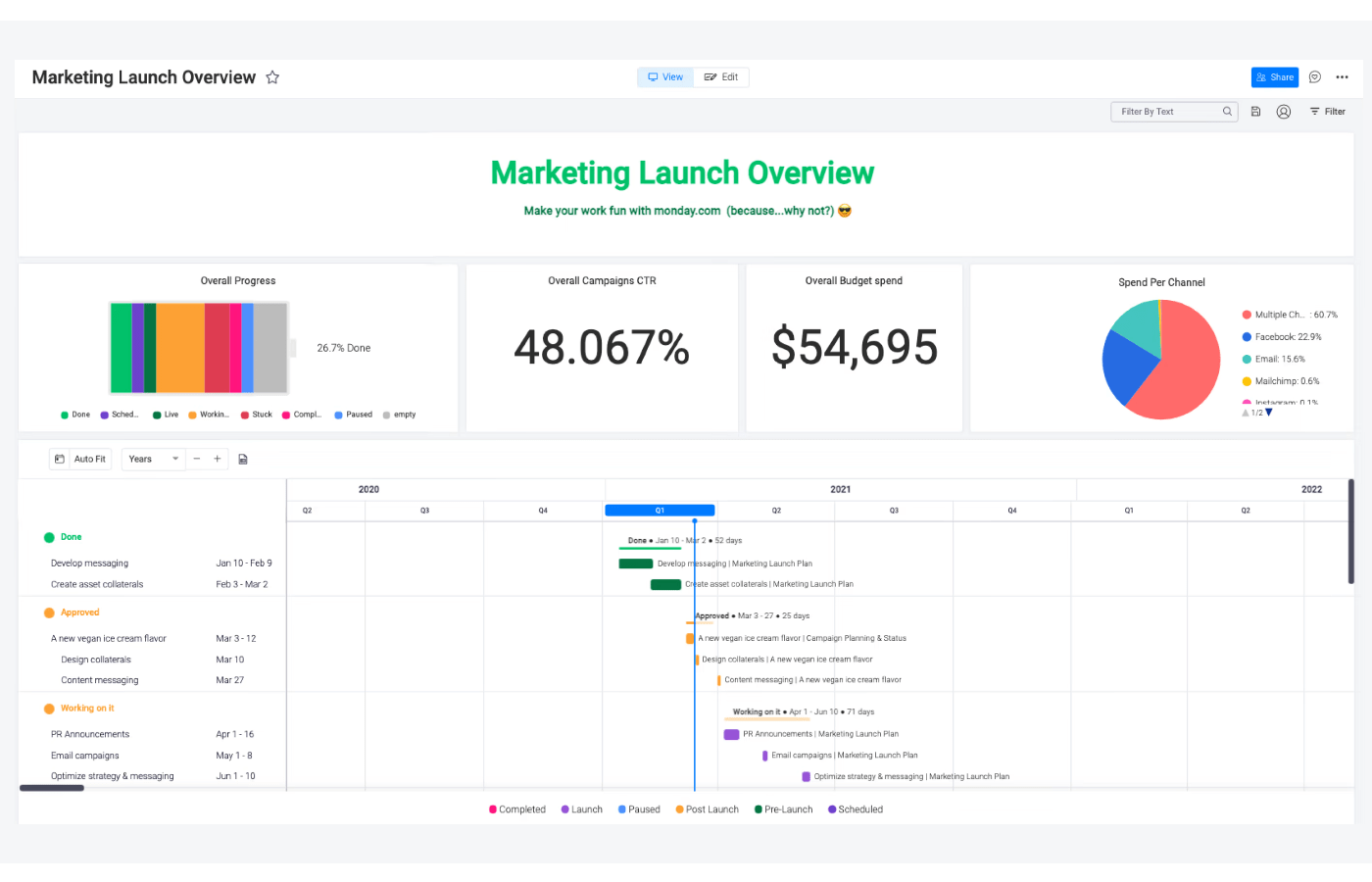
9 Worthwhile Product Launch Templates for Busy Leaders
-
by Anoop Singh
- 4
Launching a product doesn’t have to feel like blindly solving a Rubik’s cube — the right product launch template will help you map out your strategy, high-level goals, in-the-weeds details, and all the work it’ll take to get there.
These are some of the best tools and templates to start with, whether you’re introducing your first digital course or your tenth physical product to the market
monday.com: A product launch template for marketing teams
monday.com is an all-in-one tool for launching products, managing marketing campaigns, and handling dozens (or hundreds) of projects.
The free plan comes with two user seats, over 200+ templates, and three project boards. It’s fine if you’re just getting started or want to try monday.com, but teams will likely have to upgrade to a paid plan pretty quick.
My favorite product launch template is specifically for marketers — it helps ensure brand messaging is consistent and that all of your promo materials align along the way.
More on monday.com: monday.com Review | monday.com vs Wrike | monday.com vs Airtable.
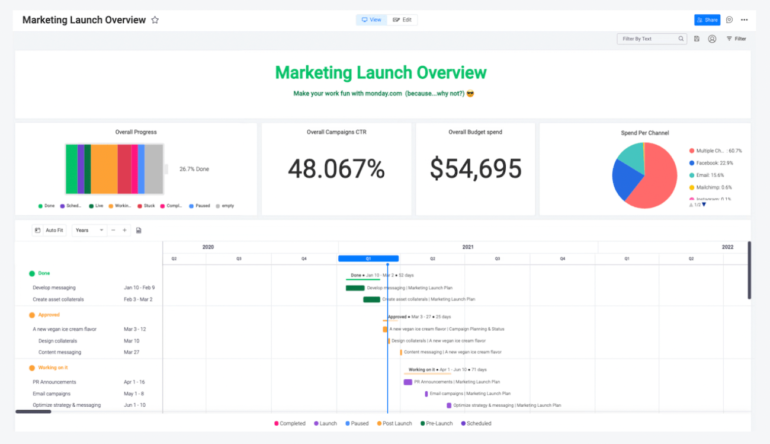
monday.com makes it easy to switch between big picture planning and weekly tasks. This helps marketing teams stay focused on their priorities while never losing sight of the high level launch plan.
It’s a fully customizable template with 30+ column types, giving you everything you need to make it work for your team.
You can use it to create pre-launch campaigns and keep all of your assets organized for emails, social posts, blogs, PR campaigns, and more. With advanced features like real-time notifications for completed tasks, you can quickly start work on the perfect email or press release when the product images or live demo is ready to share.
While monday.com is great for all types of teams, this one’s specifically focused on marketing teams.
You can share it with other department heads and leaders or connect it to other team boards within the platform, but everything was designed around what marketers need.
ClickUp: Comprehensive product launch checklist + template
ClickUp is another option that works well for teams of all sizes. Whether you’re launching a physical product or new software, the platform works great for tracking tasks and keeping your entire company on the same page.
The free forever plan is one of the best out there with unlimited users and tasks. You can use it for quite a while, even if you’re a small team.
While it’s not as flexible as monday.com, it’s more affordable and gives you far more functionality at a lower price.
More on ClickUp: ClickUp Review | ClickUp vs Asana | ClickUp vs Notion.
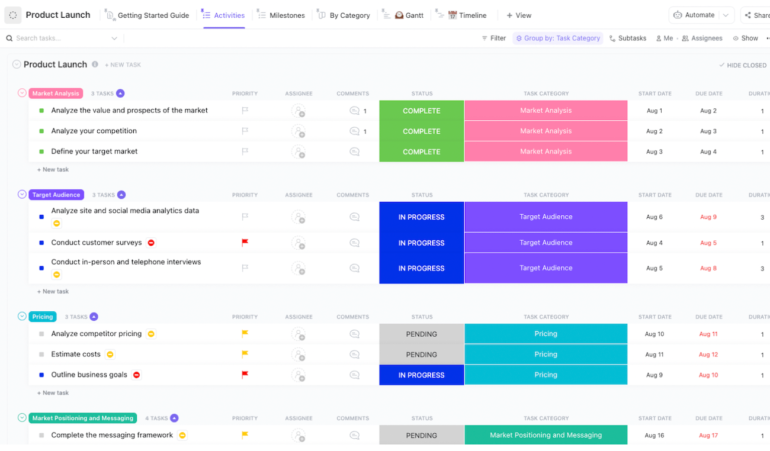
The best product launch template for ClickUp is an advanced solution for planning and executing detailed launch strategies. Out of the box, it works great for analyzing market trends, planning surveys focused on your target audience, and finalizing your pricing strategy prior to launch.
You can also create a custom checklist that includes subcategories for each task, which is super helpful if ownership of different phases is assigned to different teams.
From there, it’s easy to turn it into a timeline to ensure everything’s on schedule. You can even set milestones to signify major events along the way.
With nearly a dozen built-in project views, ClickUp makes it easy to visualize work in different ways, depending on what you want to see. Kanban board is great for individual contributors while timelines and dashboards are game changing for managers.
The biggest downside? This template is likely overkill if you’re a solo user as it has a ton of collaboration features you’ll never use.
But its flexibility, feature-rich nature, and collaborative environment make it a no brainer for teams of all sizes.
Wrike: A product launch template with sequential phases
Wrike is a more rigid project management platform that’s excellent for mid-sized and large teams. Smaller teams can use it for free, but it’s pretty limited compared to other free plans we’ve looked at as it’s not really meant to be used long-term.
Overall, it’s a great option for managing product launches because it has everything you need to execute your plan and continue supporting the product post-launch.
The official product launch template is well done with pre built views, workflows, and instructions on how to make the most of it.
More on Wrike: Wrike Review | Wrike vs Smartsheet | Wrike vs. Asana.
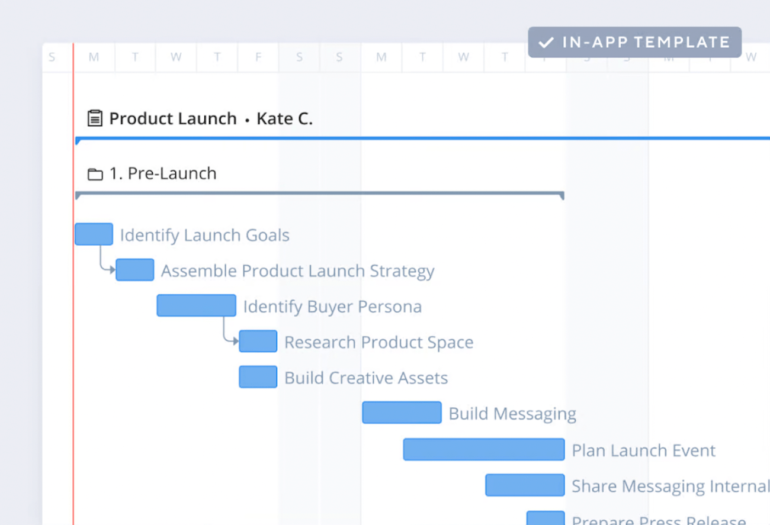
By default, this Wrike template breaks down every product launch into three distinct phases — pre-launch, product launch, and post-launch. This can help make massive projects feel less overwhelming since you can focus on the phase you’re in while planning ahead so you’re always prepared for what’s next.
The structure makes a lot of sense because most launches have tasks that should be done in a sequential order.
With other tools, tracking these dependencies can get complicated. With this template, it’s easy to set them up and understand what should happen when. After all, you can’t really work on product messaging or creatives until you’ve chosen a target audience.
Product managers can also use Wrike to identify potential roadblocks before they become a bigger problem and force you to push back your launch date.
You’ll also be able to track the progress of the entire project, each phase, and tasks with subtasks using its built in timeline view.
Once a task has a deadline, visualizing its status and understanding its impact on other parts of your launch is a breeze.
The biggest downside of this template is how long it takes to set up. There’s a bit of configuring you’ll have to do before it’s ready for you to use. You’ll likely also have to continuously make tweaks until it works how you need it to.
Teamwork: A collaborative launch template for agencies
Teamwork is a project management and team collaboration solution bundled into a single platform. It’s great for day-to-day task management and big-picture alignment — two things that are vital in rolling out new products.
Specifically, it’s for agencies, consultants, and companies that manage work across dozens, hundreds, or thousands of different clients.
It’s free for teams of up to five users. Otherwise, you can try any premium plan free for 30 days.
More on Teamwork: Teamwork Review | Teamwork vs monday.com.
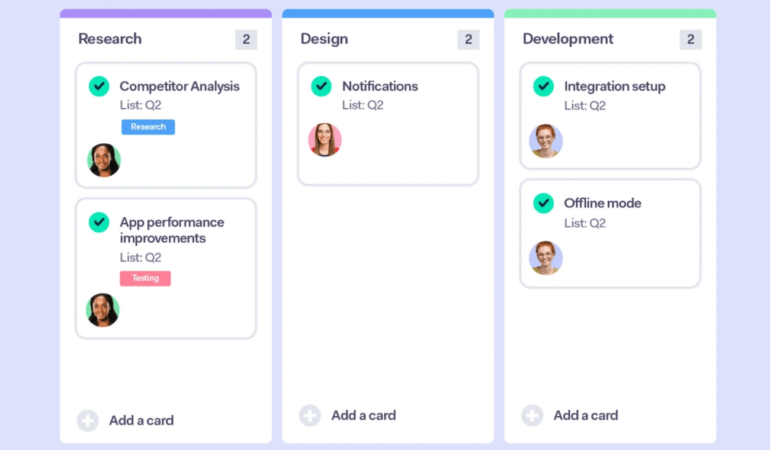
Aside from Teamwork’s built in functionality for managing client work, this template makes it easy to create a backlog of tasks, assign them to the appropriate people, set due dates, and centralize communications.
Assignees can be other people on your team, a different team, or even a client. Out of the gate, this helps hold clients accountable for their part in what you’re doing.
You can also easily add files and other assets to each card so everyone gets access to the elements that make your launch tick.
Say a designer creates a custom image and uploads the file to your Teamwork space. From there, your client can approve or reject it, triggering the appropriate workflow. If they approve, your social media manager can use the file to schedule an upcoming post to promote the client’s new product — all without a lengthy email chain or Slack thread.
Compared to other platforms, Teamwork is very straightforward and user-friendly. It doesn’t take a lot of tweaking or configuring.
This comes at the expense of flexibility. You won’t be able to make major adjustments to the platform itself so you’ll likely have to build some of your workflows around the platform rather than the other way around.
TeamGantt: A launch template for software development
TeamGantt is a project management solution known for its high quality Gantt charts. It’s commonly used by teams that use agile methodologies, like software development teams launching a new product, feature, or version release.
Aside from launches, it has numerous templates for dev teams, including bug tracking, feature backlogs, request management, and high level development plans.
The free plan is fine for a single small personal project with up to 60 tasks, although you’ll miss out on a lot of the key features that make TeamGantt a great solution.
Alternatively, you can try their Pro plan free for seven days to see if it’s right for your team before you commit.
More on TeamGantt: TeamGantt Review.
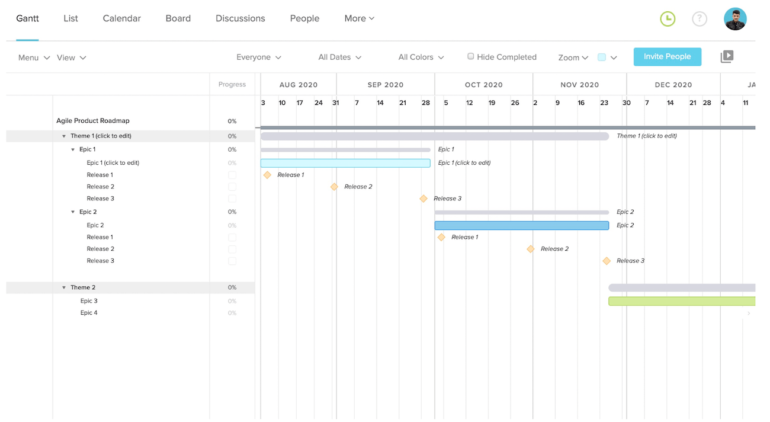
TeamGantt works well for software development because its interface should feel familiar if you’re already doing agile project management. Making the switch will be relatively easy vs spending weeks or months learning something new.
Their product launch template makes it easy to set up a complete roadmap that covers a few months, a quarter, or even half a year.
From there, managers can work with their team to outline major themes and epics before breaking everything down into even smaller sprints and tasks.
With a plan in place, you can use TeamGantt’s workload management tools to assign the work without burning anyone out. It even has built in time tracking and hourly estimating to make it easy to plan for resources ahead of time.
You can color code everything by ownership, type, or any other field you’d like to visually signal whatever you’d like.
The tool also lets you set up task dependencies to help control processes.
One last interesting point about TeamGantt is its pricing structure. You only have to pay for managers — collaborators are entirely free and you can have as many as you’d like as long as you’re on a paid plan.
Notion: High level product launch templates
Unlike the others so far, Notion is a productivity suite with project management features built in. Many individuals use it to take notes and organize to do lists while businesses can use it to manage team work, documentation, SOPs, meeting notes, and more.
It’s flexible and highly customizable, which is also one of its biggest drawbacks. It starts as a blank slate — how you set it up is entirely up to you.
If you’re someone who likes to tweak things and improve systems or processes as you go, you’ll appreciate the freeform nature. If that sounds horrible to you, you’re better off choosing something else.
Notion offers a free plan that’s great for solo users but it’s more of a free trial for teams.
There’s a massive ecosystem of Notion templates out there and I couldn’t narrow it down to just one for this post. You can use either or both, depending on how detailed you want your high level plan to be.
More on Notion: Notion Review | Notion vs Asana | Notion vs Confluence.
Template 1: A launch brief for team alignment
Notion’s product launch brief template is perfect for putting your plan in writing. While you can use it to organize thoughts as an individual user, I recommend it as a one-pager (or two-pager) for sharing those plans with your team and stakeholders.
Everyone involved can easily reference this document as a reminder of your goals, what you’re launching, and why.

It’s much simpler than anything else we’ve talked about so far. Instead of mapping out tasks and assigning them, you’ll get a template for summarizing your strategy, goals, launch date, and the responsibilities for everyone on your team.
You can also add product-specific information, like specifications, pricing, and phases.
The template includes a space to plan launch deliverables organized by status and team. There’s also a simple pre-launch and post-launch checklist included on the template. However, it’s not really meant for managing work across your team.
All of this is a good starting point but you’ll likely want to add more robust project management capabilities or pair this with another template to actually execute the plan you wrote.
Template 2: A more detailed product launch to do list
If you want to put together a more granular checklist, this template has a better layout.
It comes pre loaded with a list of action items for a typical product launch. You can easily update it to match your processes. Plus, it’s far simpler than building out an entire project management system in Notion if you don’t need to get that fancy.

By default, it comes with seven stages for your product launch — market research, goal identification, marketing plan, sales support and training, testing, launch event, and post-launch evaluation.
It includes a bunch of tasks for each stage, but you can easily add or remove stages (and tasks) based on your situation.
This template lets you tag team members and assign due dates, but it’s pretty bare bones. It’s far more suited to solo use. If you’re working with multiple people, you’ll probably need something more robust.
In that case, you can add this checklist to your project management system and then customize it, assign each task, set due dates, and manage progress without having to start from scratch.
Launch trackers for Excel, Google Sheets, Word, and PDF
If you’re working alone or launching a simple product, you probably don’t need a complete project management system. You can likely get by just fine using a spreadsheet or standard document.
While these don’t have as many collaboration features or automations, they’re far simpler and easier to use.
Template 1: 90-day product launch plan
Smartsheet is a powerful spreadsheet-based business app builder. It doesn’t have a free plan, but it does offer free spreadsheets and document templates for various use cases, including launching a new product.
Their product launch plan template is great for launches that’ll take three months or less.
You can download it and use it for free with Excel, Word, or PDF — and it’s so simple you can start planning your launch in a matter of minutes (no configuration required).
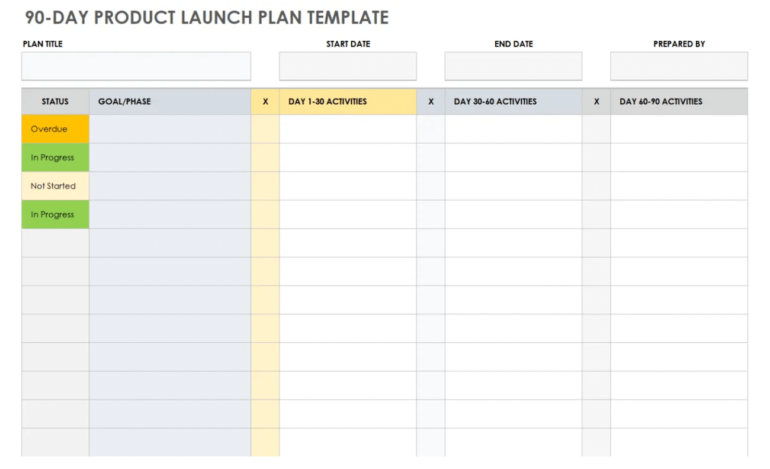
It’s broken up into segments for the first 30 days, days 31-60, and 61-90. All you have to do is add action items for each segment into the appropriate column.
Each task can have its own status and goal or phase for extra context. It may help to start by identifying key goals, phases, and milestones. From there, you can break them down further into tasks and track progress as needed.
After you’ve added start and end dates for your launch, the template will automatically highlight overdue tasks to help you prioritize them and make sure nothing slips through the cracks.
Template 2: A template for launch-specific marketing plans
Like the template above, this one was created by Smartsheet. You can download it for Excel, Google Sheets, or as a PDF for free.
Rather than covering all aspects of your product launch, this one focuses on helping you develop and execute a marketing plan to promote your new product, service, release, line, or feature.

This template is dead simple because it doesn’t include work involved with developing whatever you’re launching.
It’s solely focused on marketing activities, allowing your team to stay laser focused.
There are quite a few sections designed to help you identify key strengths, compare your product to your competitors, and position yourself in a way that will resonate with your target audience.
From pre launch to post launch, it’s a great resource anyone on your marketing team can refer to when working on assets or campaigns around your launch.
It can be especially helpful if your team manages a lot of launches — it can help everyone keep different products and services straight from a marketing perspective without having to reinvent the wheel every time.
None of these templates work for me. Now what?
You can either customize an existing template or build your own system to plan and manage the work involved. Either way, your first decision should be the software you’re going to use.
SEE: Learn about the best project management solutions on the market.
From there, you should make a list of priorities, including what you need to keep track of, different views that might be helpful, how much you’re able to spend (if anything), and how much work you want to put into setting it up.
At a minimum, your product launch solution should:
- Define the product you’re launching.
- Explain what it does and the problems it solves.
- Highlight your target market and why they should care.
- Estimated ship dates and a final launch date.
- Your high level goals and objectives.
- Specific pre-launch deliverables.
- A promotion plan if applicable.
Many of the templates above cover all of these elements and then some. You may need or want to go into more detail and that’s okay too.
Say you’re launching a new piece of software. You may need to play for beta testing, market research, focus groups, hiring developers, and training. These are all critical steps that’ll impact your launch, so they should be covered in your template as well.
SEE: Check out these free customer satisfaction survey templates if you need them.
The easiest route is finding a template for the tool you want to use that gets you as close as possible to what you need.
What’s the difference between a product launch and go-to-market (GTM) strategy?
Launching a product is a piece of your go to market strategy. In other words, your GTM strategy is broad and encompasses a lot of things, including your product launch.
GTM strategies can be used to bring new products to existing markets, current products into new markets, test new markets, and even start a new business. These strategies are typically more involved — including elements related to risk management and competitive research.
Product launches are product-specific and don’t have to rehash your overall brand, other products, or overall business strategy. Check out my favorite go to market strategy templates if you want to start there. You can always add a product launch template in when you’re ready to get more specific.
Launching a product doesn’t have to feel like blindly solving a Rubik’s cube — the right product launch template will help you map out your strategy, high-level goals, in-the-weeds details, and all the work it’ll take to get there. These are some of the best tools and templates to start with, whether you’re introducing your…
Launching a product doesn’t have to feel like blindly solving a Rubik’s cube — the right product launch template will help you map out your strategy, high-level goals, in-the-weeds details, and all the work it’ll take to get there. These are some of the best tools and templates to start with, whether you’re introducing your…
